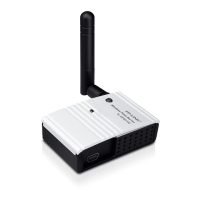
Do you have a question about the TP-Link WPS510U and is the answer not in the manual?
| Interface | USB 2.0 |
|---|---|
| Compatible Printers | Most USB printers |
| Storage Temperature | -20°C to 70°C (-4°F to 158°F) |
| Network Protocols | TCP/IP |
| Wireless Standards | IEEE 802.11b, IEEE 802.11g |
| Security | WEP |
| Management | Web-based |
| Ports | USB 2.0 Port |
| Standards | IEEE 802.11b, IEEE 802.11g, USB 2.0 |
| Operating Temperature | 0℃~50℃ (32℉~122℉) |
| Operating Humidity | 10% to 90% non-condensing |
| Storage Humidity | 5% to 90% non-condensing |
| Wireless Data Rates | 11g: Up to 54Mbps (dynamic), 11b: Up to 11Mbps (dynamic) |
Steps for physical connection, powering on, and initial self-test.
Lists default username, password, wireless mode, channel, SSID, IP, and subnet mask.
Guides users through connecting the device to the computer for configuration.
Instructions for assigning a static IP address to the wireless adapter.
Steps to connect to the print server's wireless network using the adapter.
Instructions on selecting the correct print server model from the setup wizard.
Steps to change basic settings, including entering the password.
Configure communication type, SSID, channel, and transmit mode.
Set up the print server's security features for wireless connection.
Set a static IP address for the print server within the same subnet.
Review current settings and save them to the print server.
Choose an already installed printer or add a new one for the print server.
Steps to reconfigure the wireless adapter's IP address for automatic assignment.
Connect the wireless adapter to the appropriate wireless router or access point.
Select a printer that has already been installed on the computer.
Instructions to add a new printer if it's not already listed.
Choose the option for a local printer attached to the computer.
Choose the correct port for the printer, typically LPT1.
Specify the printer's manufacturer and model for software installation.
Assign a name to the printer and choose if it's the default.
Option to print a test page to confirm successful installation.
Guide for assigning a static IP address to the wireless adapter in Windows XP.
Guide for assigning a static IP address to the wireless adapter in Windows Vista.
Links to FAQ and download pages for firmware, drivers, and user guides.
Contact details for technical support in various global regions.
